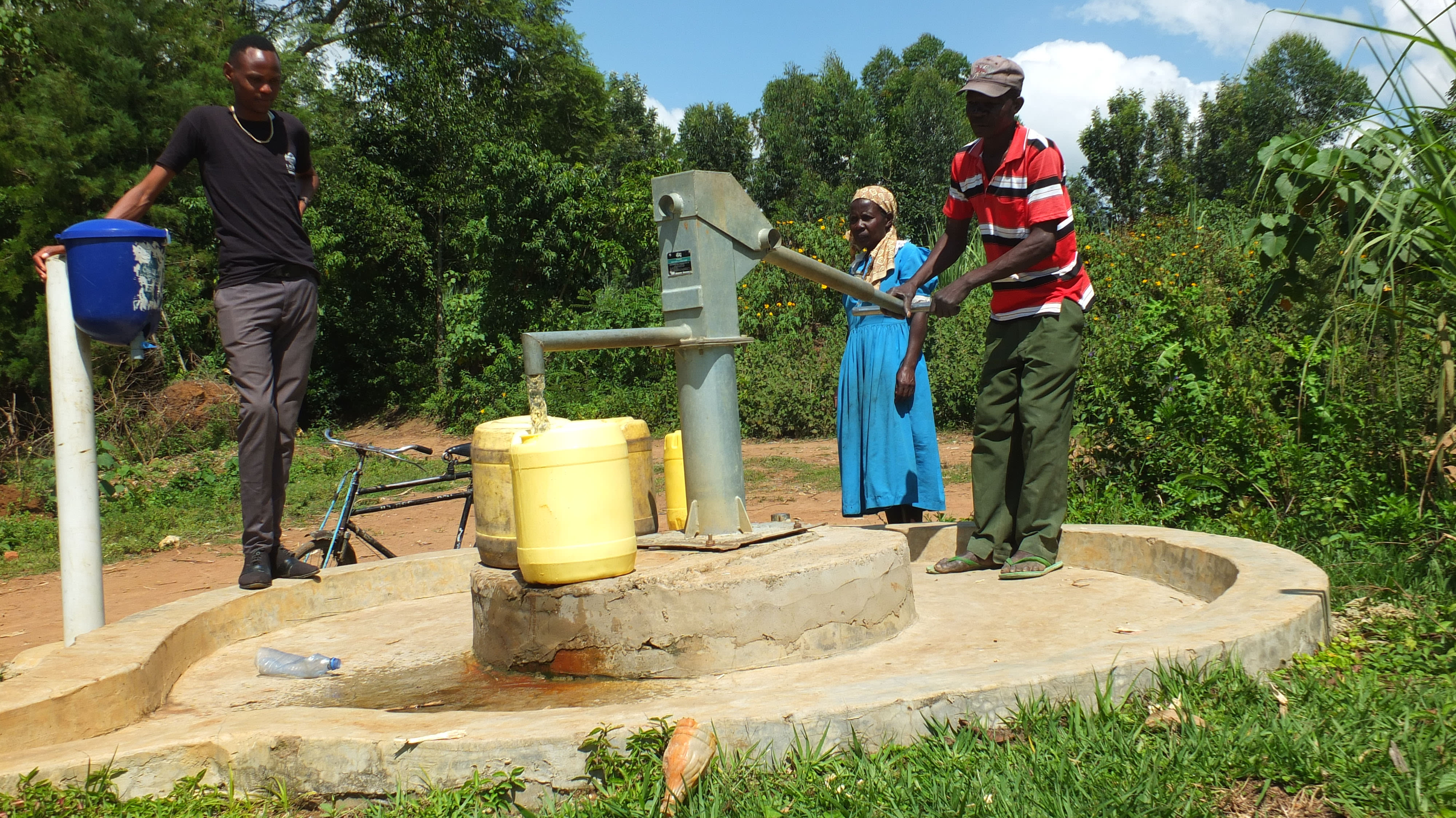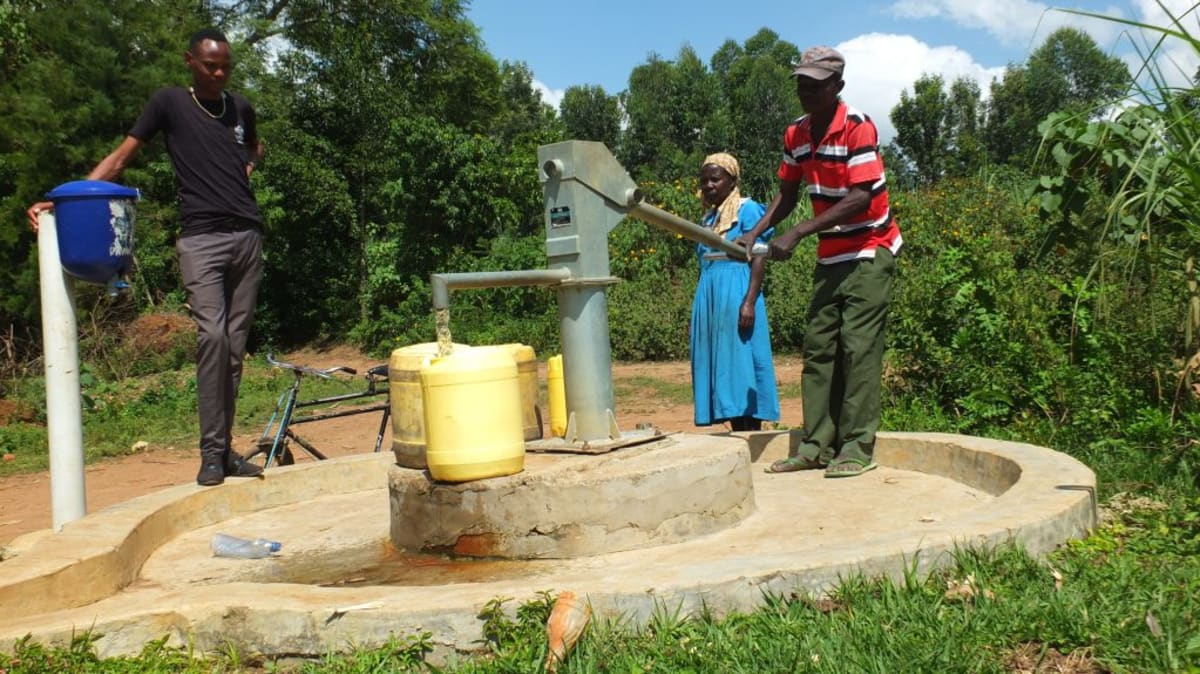This project is a part of our shared program with Safe Water and Sustainable Hygiene Initiative (SAWASHI). Our team is pleased to directly share the below report (edited for clarity, as needed).
Background Information
The Mukangu community is inhabited by people from the same sub-tribe of Kabras. Being a community, the people have a set of rules and culture in which they believe in and follow. One of the community’s cultural traditions dictates that women are in charge of all the household chores. For example, only the women are responsible for fetching and storing water. They are also the only ones responsible for maintaining hygiene and sanitation in their households. The Mukangu children go to a public neighboring school and are available to help very early in the morning and later in the day. On the other hand, men have responsibilities outside of their homes, such as providing food for the family.
The community members practice small-scale farming. Each household has a small farm used for growing crops like maize, beans, and sugarcane.
Through the help of local government leadership, a list of failed projects implemented by the Kenya Finland Company (KEFINCO) was provided to SAWASHI. This project was one among the long list that needs our attention. Keeping in mind all the requirements for a well to be rehabilitated, this project ended up being viable for rehabilitation. Some of the requirements include, 1) The well must have enough water in it. 2) The community must be willing to participate in the implementation of the project. 3) The community should have a strong water user committee that shall oversee the sustainability of the project.
The community is ready to provide a 20% contribution towards the implementation of the project. Their contribution includes materials like sand and bricks. The community is also expected to provide security for the organization’s equipment until the project is completed, and will provide food for the SAWASHI construction team.
By rehabilitating the well, only 65% of this community will be able to access safe water. Due to the span of this community, there is a need to drill a new borehole which can serve the remaining percentage who still have to walk a long way to access this project. Mukangu Village is a great candidate for continued work.
The Current Source
Kenya Finland Company dug one well in 1987 (click here to see), and implemented this hand-dug well in 1989 in order to further reduce the long distances walked by women and children in search of clean water. They sought to stymie the outbreak of waterborne diseases like typhoid and diarrhea this community suffered after drinking contaminated water.
Because there was nobody responsible for oversight and maintenance of this well, the hand pumps installed on both wells were in disrepair by the year 2012 after several attempts to repair failed. As a way of gaining the access to water in the well, the community members decided to dismantle the pump system from the well pad and thereafter use a bucket tied to a rope to fetch water.
The current water source is contaminated. Large particles of wood and leaves can be seen inside the well. The rope tied on the bucket is also dirty, given the fact that it always sits on the ground and is then frequently dipped in the water. It was also evident that not only was the bucket used for fetching from the hole dirty, but the water containers brought for water storage were dirty. Workers also noticed that these water containers have a green film on the inside and do not have covers for safe storage.
The locals drawing water from this contaminated well are not aware of the need to treat it before drinking. Both children and the elderly are often plagued with diarrhea. "Since we have no access to safe water, our children have regular diarrhea diseases for which we spent all of our little money treating them. This in turn renders us poor people. Typhoid has also become a threat to this community especially to the aged men and women," said Mr. Zacharia whose homestead is next to the well site.
Sanitation Situation
75% of households in Mukangu Village have dug pit latrines. These latrines often have three walls for privacy, but no door to cover the entrance. Nor is the pit itself covered, making it very easy for flies to enter and leave carrying dangerous waste. The flies attracted to the latrines are the same flies attracted to the kitchen.
It was observed that no households have hand-washing facilities, and no more than 75% of households in this part of the village have helpful tools like dish racks or clotheslines. Most households have no designated place to dump their family’s waste, so choose to dispose of it in the surrounding banana plantations.
Our partner believes the community is aware of their need to live healthier, and will greatly benefit from hygiene and sanitation training.
Training Sessions
Community members of Mukangu Village will be recruited to attend training for three days. On the first two days, the facilitator will focus on hygiene and sanitation practices. On the third day, the community and partner will work together to form and educate a water user committee. This committee will manage and maintain their community well. The facilitator plans to use the PHAST (participatory hygiene and sanitation training) method and group discussions to teach health topics. By the end of training, community members will realize the importance of good hygiene and sanitation and will be able to apply new practices like hand-washing, proper water storage and food storage.
Unlike other projects, the Mukangu project has inspired the participation of local government leadership. The assistant chief of this community played a big role in helping us mobilize community members. Being a community that has many local farmers, and now that it is planting season, it will be a big challenge to bring all the community members together for the purpose of hygiene and sanitation trainings.
Beyond this, unforeseen events are really affecting the implementation of the project. For instance, it is taboo in this community for one to work if there is a funeral in the neighborhood. This therefore calls for our patience as we wait until the funeral is over. The roads leading to this community are also a challenge, especially during these rainy seasons. Though the roads are tough, we anticipate to complete the project on time.
Results: Training
The community members converged at the assistant chief's office for training. They all agreed to meet there because it is a common, well-known location. The assistant chief was also crucial for the mobilization of training participants; he made sure that at least 15 representatives of every community in the area were present. Thus, attendance was very good, and participation was also a success. Men and women openly discussed problems and questions in regard to the hygiene and sanitation situations in their communities.
The following topics were covered during the three days:
- Proper hand-washing
- Food preparation and storage
- Water treatment and storage
- Prevention of diarrheal diseases
- General household hygiene
The facilitator encouraged group discussions through the display of pictures and posters. These illustrated both good and bad hygiene practices, and training participants were tasked with determining these. The group also had a chance to watch the facilitator demonstrate how to properly wash hands, as well as practice in front of each other.
The facilitator believes these trainings were effective, because the representative from each community complimented each other. Each person's situation was different, and they were able to share their observations and experiences of both the good and the bad. Because of these different perspectives, the facilitator believes each participant was able to learn much more than if all had been from the same community. Mrs. Beatrice Atuka is a Mukangu housewife. After training, she said, "We are the victims of typhoid, diarrhea and many other waterborne diseases because of our ignorance and attitude towards practicing proper hygiene and sanitation. From this moment I will practice proper hygiene and sanitation to avoid expenses of treatment."
The results of this training will be assessed when WEWASAFO returns to the community for monitoring and evaluation.
Results: Construction
The rehabilitation of this hand-dug well presented no challenges or hiccups to the work team. On February 10, the men started by using hammers and mallets to demolish the old well pad that was cracked and allowing contamination. The construction team then used a mixture of cement, sand, concrete, and water to reconstruct the well pad.
The community kept involved in this process, making sure the work team always had food! The roads to this community are rocky and difficult to navigate. So between the difficult trip and the hard work at this well, the work teams sure did appreciate the good care this community provided.
Mr. Bernard Akoi, a farmer in Mukangu, expressed his gratefulness by saying, "We have been drinking contaminated water because of the unprotected well. We are happy for protecting our water system. Now we will have clean and safe water in place."
The water user committee and the local leadership have promised to take full responsibility of managing the water source so that it can serve more generations to come. The community appreciates the successful rehabilitation of the well, hoping that the flowing water will unite them as one community.

 Protected Dug Well
Protected Dug Well





















